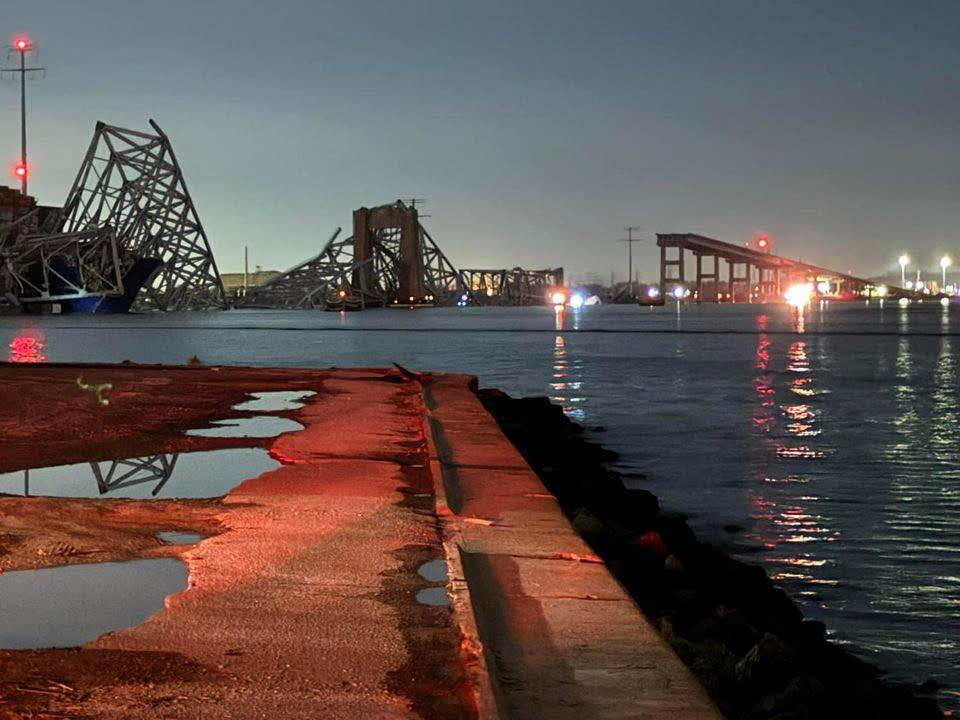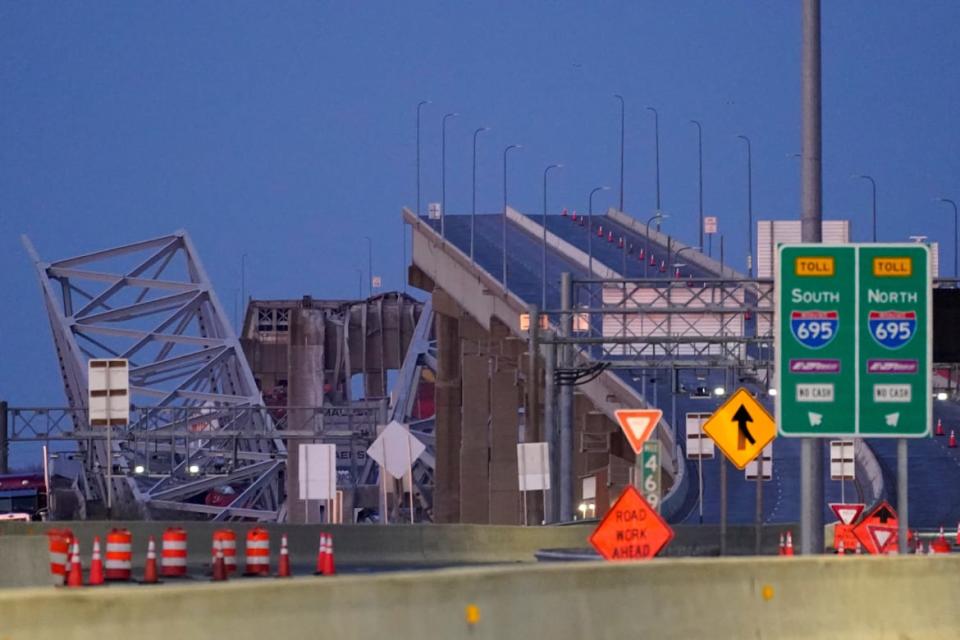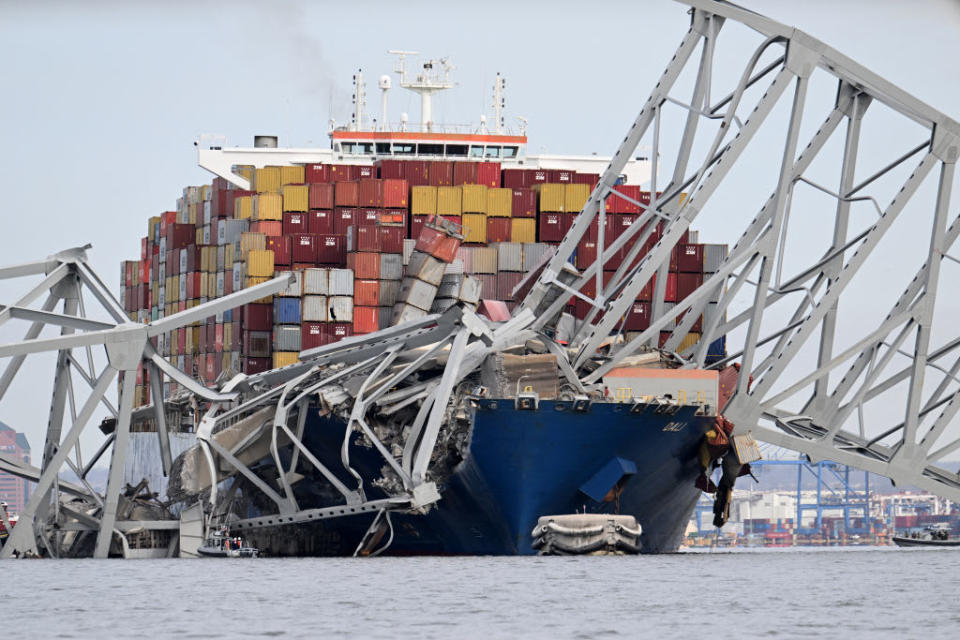Baltimore Ship Lost Power and Sent Mayday Call Just Before Bridge Disaster

- Oops!Something went wrong.Please try again later.
Officials said Tuesday that the container ship that crashed into Baltimore’s Francis Scott Key Bridge issued a “mayday” just before the collision, allowing bridge operators to halt traffic and potentially save lives.
Six people remained missing Tuesday afternoon after the cargo ship Dali reported losing power and struck a pillar of the bridge, sending vehicles and a group of contractors plunging into the Patapsco River.
James Wallace, chief of the Baltimore City Fire Department, said two workers—who’d been fixing potholes on the bridge, which is used by 31,000 vehicles per day—were rescued from the frigid water. One avoided injury, and the other was hospitalized with serious injuries, he said.
That patient was discharged by Tuesday afternoon, the University of Maryland Medical Center said in a statement.
Authorities said several vehicles, including one the size of a tractor-trailer, were on the bridge when one of the structure’s columns was hit by the ship just before 1:30 a.m. Tuesday. Maryland Gov. Wes Moore said more vehicles didn’t suffer a similar fate largely because of that “mayday” call.
Video clips of the collapse show the steady flow of headlights disappear from the bridge just before impact.
“We’re thankful that between the ‘mayday’ and collapse that we had officials who were able to—to begin to stop the flow of traffic so more cars were not up on the bridge,” the governor said.

The bridge after its collapse.
A Broadcastify recording of the transmissions captured the final seconds before impact, with authorities calmly communicating that all traffic needed to be stopped on the bridge.
“I need one of you guys on the south side, one of you guys on the north side, hold all traffic on the Key Bridge,” an unnamed person said. “There’s a ship approaching that just lost their steering, so until we get that under control, we’ve got to stop all traffic.”
Clay Diamond, the head of the American Pilots’ Association, a trade organization for ship pilots, told the Associated Press the ship’s captain also ordered the crew to slam the rudder hard toward the ship’s port side and dropped its port anchor in a desperate bid to slow the vessel.
The bridge collapsed about 90 seconds later, the audio showed, with someone exclaiming, “The whole bridge just fell down. Start, start whoever … everybody. The whole bridge just collapsed.”
Moore emphasized that the tragedy was a horrific “accident,” saying there was no evidence to suggest it was an intentional act.
Jesus Campos, an employee of Brawner Builders, told the Baltimore Banner that the missing workers were men in their 30s and 40s from El Salvador, Guatemala, Honduras, and Mexico. He said they each came to Maryland in search of a better life for their spouses and children.
“They are all hard-working, humble men,” he added.
Wallace said dive teams were leading the search for the rest of the missing and that the temperature of the water—reportedly around 50 degrees—and the incoming tide would affect their efforts.
“I can tell you our sonar has detected the presence of vehicles submerged in the water,” he added, saying he did not yet know how many.

The Francis Scott Key Bridge following the collapse.
Baltimore’s police commissioner, Richard Worley, told reporters early Tuesday there was “absolutely no indication” the ship had hit the bridge intentionally.
Joe Biden addressed the collapse before making a trip to North Carolina with Vice President Kamala Harris. He remarked that he’d traveled on the bridge “many, many times” while traveling between Washington and his native Delaware, adding that he plans to visit the collapse site “as quickly as I can.”
The president added that he wants the federal government to take on the full cost of rebuilding the bridge.
“It’s my intention that the federal government will pay for the entire cost of reconstructing that bridge,” he said from the White House. “I expect the Congress to support my effort—this is going to take some time.”
Maryland State Transportation Secretary Paul Wiedefeld, describing the “catastrophic” collapse, said, “We know there were individuals on the bridge at the time of the collapse, working on the bridge, contractors for us.”
The bridge, completed in 1977, was not equipped with large “dolphins”—a group of pilings arrayed together to protect bridges from collapsing after a collision. Large dolphins have been installed around bridges near major ports in the aftermath of the Sunshine Skyway Bridge disaster in 1980—an incident that left 35 dead after the bridge collapsed into Tampa Bay after being struck by a cargo ship that went off course in heavy fog.
The Dali, a 948-foot, Singapore-flagged cargo ship, had been inspected 27 times since it was built in 2015, with “deficiencies” being found on two occasions, according to records from the Electronic Quality Shipping Information System.
One deficiency was noted last summer by Chilean authorities, who said the ship had a “propulsion and auxiliary machinery” deficiency—something that was cited as being an issue with the vessel on Tuesday by the Cybersecurity and Infrastructure Security Agency (CISA), which wrote that the Dali had “lost propulsion” while leaving port.
The Dali’s other noted deficiency came after it was involved in a separate collision in 2016. That’s when it struck a stone wall at a dock in Antwerp, Belgium, which damaged its hull. The collision forced it to be docked for repairs, but nobody was injured. According to Vessel Finder, the blame for that incident was placed on the ship’s master and pilot on board—not the weather or mechanical issues.

The Dali after the bridge collapse.
The Dali was not being piloted by its own crew at the time of Tuesday’s collision, either. It was instead being directed out of port by local pilots—a practice used worldwide to avoid collisions like the one that happened Tuesday. Local pilots steer outbound ships out to the open water before leaving the vessel to its regular crew, and board inbound vessels just before they reach local channels.
Tracking data from Tuesday shows that the Dali came to a complete stop under the bridge, according to the MarineTraffic platform. It also shows the vessel left Baltimore before 1 a.m. Tuesday on a voyage to Colombo in Sri Lanka.
“The words that the ‘Key bridge are gone,’ it still shakes us,” Moore said Tuesday, recalling the moment he heard the bridge had collapsed.
John Zimmerman, an 83-year-old retired ironworker, was one of the workers who built the bridge in the 1970s. He told CNN that he was in “shock” and didn’t think the bridge would ever come down.
“It looks like it hit the only spot it could have hit to take the whole thing down,” he said. “It hit at probably the weakest part of the bridge.”
U.S. Transportation Secretary Pete Buttigieg was being dispatched to the bridge site Tuesday, a staff member told CNN. Both U.S. and Singaporean authorities announced that they will launch a probe into the incident.
Baltimore Mayor Brandon Scott said at the Tuesday morning press conference that the collapse was “a tragedy that you can never imagine,” and that though video of the incident “looked like something out of an action movie,” the focus should be on the victims and their families.
The Maryland Transportation Authority told drivers to avoid the area because the bridge—which carries Interstate 695 over the river—had collapsed “due to ship strike.” The bridge’s collapse is expected to cause significant traffic jams in and around Baltimore, and the inevitable closing of the city’s port is expected to bring shipping traffic to a halt—a particularly large blow to automakers that use the Port of Baltimore to export American-made cars.
The Danish shipping giant Maersk confirmed that the Dali was carrying Maersk cargo, and a spokesman said the company was “horrified by what has happened in Baltimore, and our thoughts are with all of those affected... No Maersk crew and personnel were onboard the vessel.”
“The bridge is gone”: Video from an eyewitness shows part of the Francis Scott Key Bridge in Baltimore completely missing early Tuesday after authorities said it was hit by a large container ship. https://t.co/9C5x7VXehR pic.twitter.com/DfKesPAgMV
— CBS News (@CBSNews) March 26, 2024
Maersk added later Tuesday that it was dropping Baltimore from all its services for the “foreseeable future,” citing the collapse.
“Due to the damage to the bridge and resulting debris, it will not be possible to reach the Helen Delich Bentley port of Baltimore for the time being,” the company wrote.
Scott Cowan, the president of the International Longshoremen’s Association Local 333 in Baltimore, Maryland, said the collapse could cripple Baltimore’s economy and put hundreds out of work.
“We are at a standstill,” he said. “We make our living off of import and export cargo, unloading and loading, discharging and loading ships.”
A statement from shipping company Synergy Marine Group confirmed its container ship hit a pillar on the bridge, according to the BBC. It said all of its crew members had been accounted for and no injuries had been reported. “Whilst the exact cause of the incident is yet to be determined, the ‘Dali’ has now mobilized its Qualified Individual Incident response service,” the statement said.
The 1.6 mile-long bridge, which was named after the author of “The Star-Spangled Banner,” had been open and housed the interstate since 1977.
Get the Daily Beast's biggest scoops and scandals delivered right to your inbox. Sign up now.
Stay informed and gain unlimited access to the Daily Beast's unmatched reporting. Subscribe now.

